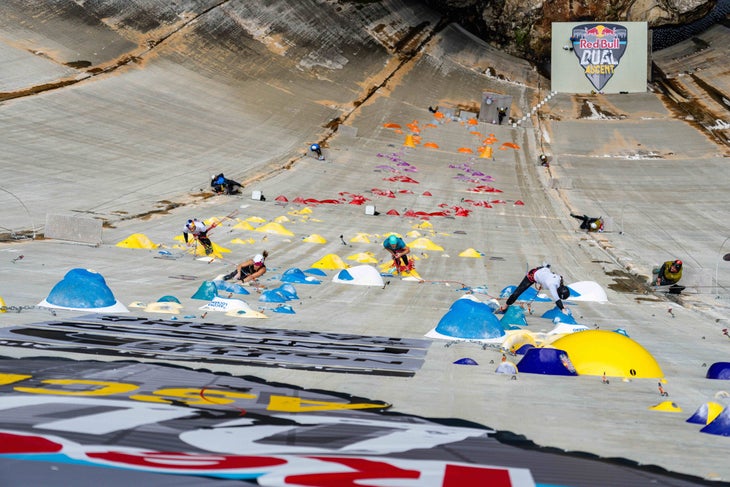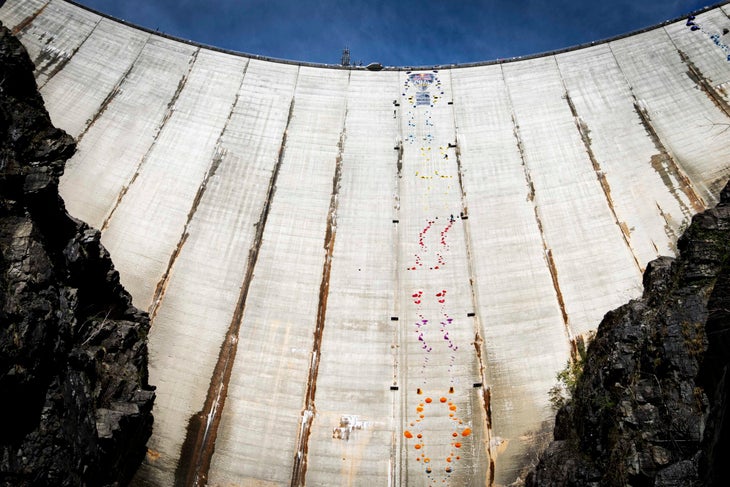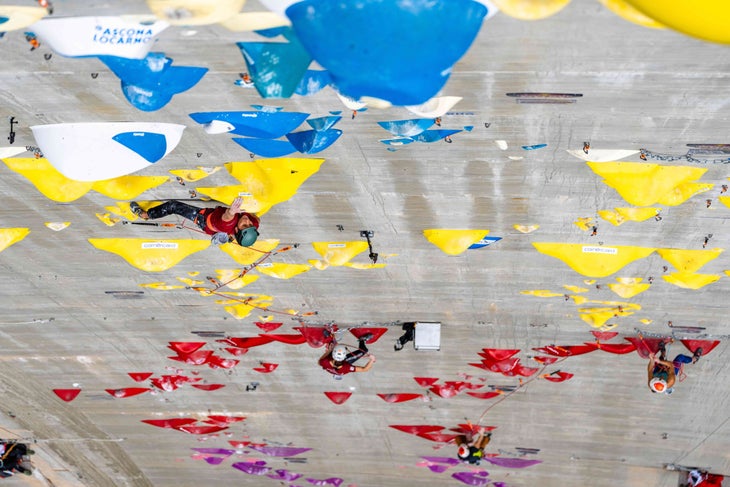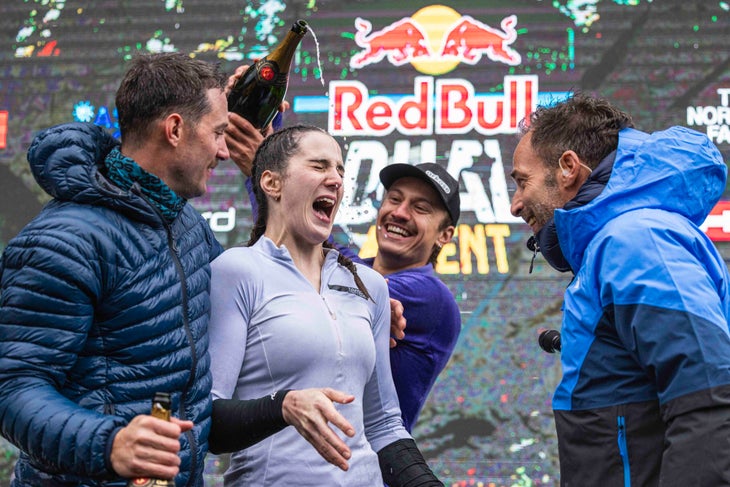Heading out the door? Read this article on the new Outside+ app available now on iOS devices for members! Download the app.
Renowned for its slightly wacky sporting challenges (Flugtag, anyone?), Red Bull’s event roster features a number of hybrid formats that combine extreme or mountain sports with elite athletic competition, and sometimes just a dash of absurdity.
Red Bull’s Dual Ascent competition is, in some ways, the perfect event for the current generation of elite climbers: a cohort of boulderers, sport climbers, and big-wallers who have no issue switching rapidly between disciplines. So why not put them to work on an almost 600-foot artificial multi-pitch route on a concrete dam wall?
It’s certainly not a traditional concept, and one that undoubtedly garners eyerolls from the purists. But for me, this sort of bizarre idea—bolting a massive, hydroelectric dam wall with two identical gymnastic sport routes side-by-side, and pitting teams of some of the world’s best climbers against one another—is a pretty cool one. Visually it’s spectacular—unequivocally a spectator sport and almost better watched on screen than peering gingerly over the rails at the dizzying sweep of gray concrete below. With six pitches starting at 5.11b and increasing in difficulty towards the route’s 5.13c climax, the route is set to play to different climbers’ strengths and weaknesses equally. The exposure on the wall is enough to have most mortals utterly gripped, and if you’re wondering if weather conditions affect concrete? Yes, yes they do.

Looking back on footage from last year’s event, you’d be forgiven for thinking that it took place at a totally different time of year—though in reality they were only a week apart. In stark contrast to the continuous sunshine glaring off the wall in 2022, this year saw murky skies, cold winds, and high humidity. While the air temperature was lower and the rain held off until the winning athletes were thoroughly soaked in champagne on the podium, I couldn’t help but wonder which would be worse. I didn’t notice anyone reaching for a can of Red Bull from the in-situ belay fridges, anyway.
While some teams hadn’t climbed together prior to the event, there were certainly some more obvious pairings in the mix. For US climbers, Matty Hong and Nina Williams teaming up was a no-brainer. It was Hong’s second time on the Dual Ascent wall, but this would be Williams’s first stab at the dam thing.
“Last year was a bit of an unfortunate year because I ended up getting hurt during one of my falls and we had to go down from the route,” Hong recalls. “It was nice to get invited back again this year and have another shot—it’s a pretty cool experience. We definitely learned some things in the few pitches that we did get to climb last year. I felt like we tried to go really fast the first year and this year was more about a consistent, steady pace.
“Nina and I have known each other for a long time, so we have good camaraderie and good energy together on the wall. She also has a lot of experience with scary situations: highball bouldering and multi-pitch climbing. So yeah, she seemed like a good partner this year to tackle the challenge!”

(Photo: Stefan Voitl / Red Bull Content Pool)
While arguably best known for scary-looking highball sends, Nina Williams is no stranger to hard multi-pitching either, with ticks of Yosemite routes Final Frontier and Father Time (both 5.13b) under her belt. In line with its esoteric style and surrounds, the Dual Ascent route throws a few variables into the mix that even Williams admits are a little unnerving.
“There’s a really interesting component here because you’re on a concrete dam wall that’s a little crumbly, a little dirty, and you have these plastic comp holds that are super textured with good friction, which is nice. But then there’s dirt and there’s moisture. You’re looking up into the sky like: what are the conditions today? Is it gonna rain? Is it gonna be nice? So we’re thinking about climbing in a way that we never have before,” she says.
“I guess no, it’s not my scariest experience yet, but definitely a more unique, scary experience!”
Matty and Nina ultimately placed tenth in the qualifiers with a total time of 1:30. Having put in a strong performance, their total of nine penalty points saw them exiting the competition early to cheer on the remaining climbers in the Small Final (yes, that’s right, small) and Final heats.

Dual Ascent competitors are scored not only on the time it takes them to get to the top, but also receive penalty points for falls on the route. If a competitor lowers back to the beginning of the pitch they fell on and climbs it clean, the penalty points are removed. This scoring system made for a very tense finale, with the Kruder siblings and last year’s winner Ginés López and teammate Kazbekova fighting it out on the final and most technically difficult pitch. With Ginés López and Jernej at the top, it was down to the women to secure the win. Kazbekova took a fall on the final lip, opting to press on and accept the penalty points. When Julija took a whip, however, the Kruders decided that she would re-climb the pitch in an attempt to scrub their penalty points. Utterly exhausted and looking—quite frankly—a little bit pissed at her decision, I wondered what was going through Julija’s head as she returned to the penultimate belay.
“When I was lowering down, I was like: I cannot do it again,” Julija explains. “I was so tired, I just wanted it to be over. I didn’t know if I could do even five moves, let alone the whole pitch again.
“I didn’t want to waste everyone’s time. I just needed to rest enough to climb the last pitch. I was so relieved when I got to the top!”
After what seemed like a pretty short rest for someone who had just climbed 5.13c and was about to do it again, Julija proceeded to execute every move with impressive precision and determination. Perhaps in some small part motivated by her brother, who was overheard to promise through their radio headsets that he would shave off his moustache if they were victorious, Julija wiped the scoreboard clean and sealed their victory. You couldn’t have asked for a more exciting final, really.

Back to the purists—I see you. A branded, commercial, comp-style event, internationally live streamed with parkour-esque problems? Roll your eyes all you like, the internal workings of this event are impressive. The athletes are impressive. The route setting is impressive. It’s a spectacle for climbers and non-climbers alike, and at least they’re only bolting concrete.
With yet more implausibly talented climbers emerging in various disciplines and onto multiple scenes (and in some cases, all of the scenes), I can’t help but wonder what will be next to emerge from the Red Bull imaginarium of weird and wonderful hybrid events that, somehow, just kind of work?
Check out the highlights from the event here.
